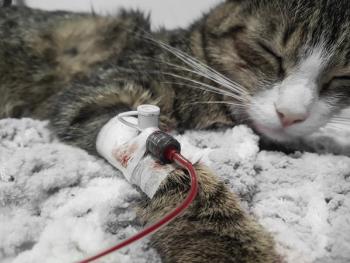- Reduced energy levels and lethargy
- Panting
- Sunken, dry-looking eyes
- Dry, sticky gums
- Thick saliva
A test that particularly comes in handy to determine if a dog is dehydrated is examining the skin tent. Pardo said, “The skin tent, basically, you're just going to grab that loose skin, lift it completely up, and then see how many seconds it's going to take for it to snap back, it should snap back within a second, anything more prolonged than that means that the patient potentially is dehydrated.”
Tips on keeping pets hydrated
Understand the pet’s body language and dehydration signs
Pardo advises owners to get accustomed to examining their pet at home and learning their body language, so they know what is “normal” for the dog so it’s clear when something is wrong. She also suggested they be informed about dehydration risk factors and symptoms to recognize.
“Is a pet excessively thirsty, or do they look more tired than usual? These are things that when you're going out for a run or let's say you're taking your dog to the beach, that you should be looking out for to know, okay, maybe a patient is going to become dehydrated. The more that you educate yourself on it, the more that you can try to prevent it,” Pardo said.
Carry and provide enough water
Collapsible bowls and other dog-specific water bottles are available for owners to travel with whenever leaving the house or going on a trip with their pet. When at home, pet owners should provide their dog large water bowls or a water fountain, so they have an ample amount of water available.
Gaylord added helpful advice, “If you're worried about [your dog] not drinking enough, you can even flavor the water a little bit. I have pet owners putting in a little bit of chicken broth or a little flavoring that [the dog likes] in their water . . . that can go a long way in promoting drinking.”
Gaylord also mentioned that they can feed their dogs ice cubes in small amounts or add water on top of their wet or dry foods.
Don’t exercise dogs excessively in hot environments
When dogs are engaging in activities in outdoor environments, their time should be limited. Plus, they should have enough water and access to areas of shade to cool down appropriately before they continue to play, Pardo concluded.
References
- How much water should a dog drink? PetMD. Reviewed and updated for accuracy on August 11, 2020. Accessed June 14, 2022. https://www.petmd.com/dog/nutrition/evr_dg_the_importance_of_water
- Reisen J. Warning signs of dehydration in dogs. American Kennel Club. June 29, 2021. Accessed June 8, 2022. https://www.akc.org/expert-advice/health/warning-signs-dehydration-dogs





